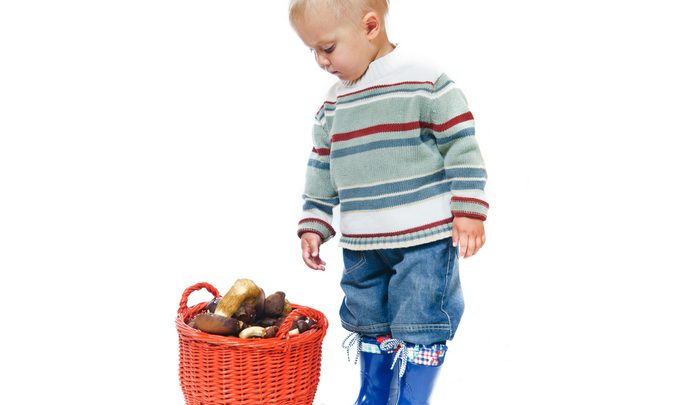“We Want To Learn About Mushrooms!” – The Excitement (And Mild Terror) Of Child-Led Learning

A growing number of teachers are stepping away from adult-initiated activities and letting children take the lead, but how hard is it to change your approach? Sophie Blackwell shares her experiences…

My decision to follow the interests of our children with no prior planning or focus activities was tinged with both excitement and mild terror.
When I thought about the way I’d been teaching in the past – the way in which I thought I was expected to teach – I was all too aware that I hadn’t really been following children’s interests at all. I was bending them to suit my own agenda, planning lessons and activities based around what I thought they wanted to learn.
There was no denying the hours I spent intricately planning lessons that would somehow capture their imagination whilst ticking the EYFS boxes – but no matter how stretched my smile or chirpy my voice, I wasn’t engaging each and every child in their learning. I was sure that there must be a better way, but the thought of stepping away from the comfort of the familiar filled me with fear. How would I make sure all the children achieved their early learning goals (ELGs)? How could I generate enough observations for each child to ensure that their learning journey was documented? How would I convince my head that this was the right way to go? Despite my trepidation, I resolved to give over all the learning to the children: I wasn’t going to do any more forward planning – the children were learning all the time. I just had to open my eyes and ears to the opportunities all around me – and there would be no more topics that we as teachers deemed interesting (the children’s project choices so far have centred on mushrooms, catalogues, ramps, bones and, most recently, padlocks!).
Utter bliss
Once I’d made my decision, I was determined to find the evidence to support it. I devoured books, journals, magazines, blogs and social media, trying to decide how we could make the change while ensuring we were meeting the needs of all the children in our care. It was well worth the effort. The first few weeks of our child-led approach were utter bliss. I couldn’t believe the change in nearly every child in the class. Quiet children were finding a voice; those disengaged with learning were asking to write and count; pupils with social difficulties were working together on shared projects. Our children were happy and leading their own learning – and what’s more, I had no forward planning to complete or group activities to organise.
Yet those earlier questions still floated at the back of my mind. Tthe more we explored the child-led approach, the more we encountered hurdles to overcome and decisions we needed to make.
Top-down pressure
One of the most frequently asked questions about completely child-initiated learning environments concerns how to ensure equal coverage of the ELGs. We all experience that top-down pressure, and the expectations of the Year 1 teacher alone are enough to make anyone anxious about the end of year outcomes.
When you break down the ELGs and look at each one in detail, however, it’s surprisingly easy to see how nearly each one can be achieved through children’s everyday play. For example, E and L were playing in our role-play area, currently masquerading as an investigation station for flowers and seeds:
L: “Can I have that jar?”
E: “The big one or the small one?” E turned to me, “All the jars are different sizes!” she exclaimed. “They get bigger and bigger.” [Maths ELG – talking about size]
L: “I’m getting these (flowers) for a wedding.” [Understanding the world – communities and traditions]
Teacher: “Wow. You have lots of flowers there. I think you’ve got more than me. I’ve only got (teacher counts) one, two, three, four, five.”
L then counted her 12 flowers. [Maths ELG – counting with numbers to 20]
E: “Put your flowers on top of that table.” [Maths ELG – exploring position]
To maximise the opportunities for learning in a child-led classroom, it’s imperative that the environment and resources are carefully planned. Our continuous provision provides children with easy-to-access resources encompassing each of the seven areas, with regularly updated enhancements according to particular interests.
For example, we currently have a variety of metre sticks, rulers and tape measures in the classroom after children expressed an interest in measuring the height of their classmates.
Finding the ‘wow’ moments
For many of our staff, finding those moments from which projects or interests arise has been challenging. It can be difficult to know how or when to extend the learning, or how to look for those ‘wow’ moments as one of our practitioners loves to call them.
The truth is that those moments can be fleeting, and that it will be challenging at first. Aside from knowing the early years outcomes and the ELGs in great detail (and you really do have to know them very well), our most effective strategy has been to become involved in the children’s play. When you aren’t worrying about recording an observation – and more to the point, when you don’t have a focus activity to complete – it allows you the time to really connect to the children.
We support the children’s investigations, offering suggestions when necessary and encouraging new thought. It’s because of this that I now feel I know every little soul in my class, far better than I ever did before. I know them because I spend true, quality time with them each day. It has taken the children a little while to adapt to our different way of working, and to understand that if they come to me with an idea and say, ‘I’d like to write a story’ or ‘I’ve found a seed, can we plant it?’ I will respond with a resounding, ‘Let’s do it!’ Despite all the apprehension, I know this for sure: my pupils have never been so happy, and my teaching – my cooperative exploration with those fascinating young minds – has never been so exciting.
The most recent comment I received from my head? “The difference child-led learning has made to our early years is outstanding.” So challenge yourself to be brave and try it – I promise that you will find it liberating.
First steps
How to make a success of child-led learning…
• Make sure you read all you can on child-led learning, but adapt each philosophy or method Every setting is as unique as every child; what works for one will almost certainly not work for another.
• Don’t dive in It may be a good idea to retain a few adult-led activities a week until you and your staff feel comfortable with the new way of working.
• Create a way of recording the learning that has taken place through child-led activities A large A3 sheet divided into the seven areas is an easy way of retrospectively jotting down the main projects and interests that have been followed each week.
• Pay attention to the interactions between adults and children Sometimes becoming involved is far more meaningful than observing from a distance. Follow two or three focus children each week, but don’t feel the need to record every moment.
Sophie Blackwell is a Reception teacher and head of early years at Moorfield School and Nursery, Ilkley; for more information, visit www.moorfieldschool.co.uk or follow @moorfieldilkley











